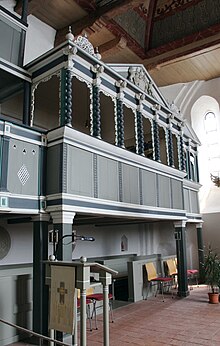St. Bartholomew Church (Dornum)
The Evangelical Lutheran Bartholomäus Church is in the East Frisian town of Dornum and was built on a terp at the end of the 13th century .
History and description of the building
In the Middle Ages, Dornum belonged to the Archdiocese of Bremen and was under the broadcasting area of Ochtersum . In the course of the Reformation , the congregation switched to the Lutheran creed.
The brick church was built around 1270 to 1290 on an eight-meter high tower as a rectangular hall church. The granite foundations are visible on the east wall and partly on the south wall. The east side is richly designed: of the five clover-leaf arches , the outer cladding features a brick pattern, the middle three are broken through by narrow windows. There are five ogival panels in the gable area. Two of the three windows on the south side were enlarged around 1500, provided with pointed arches and divided by a central bar, while the Romanesque round arched windows on the north side were preserved and surrounded by a round bar. On the inner east wall, a large round arch surrounds the three windows, which are reminiscent of an original apse, but there are no signs of this in the masonry. The building originally had three domical vaults , but these were torn down in 1750. In the course of this, the ship was shortened in the west by about 3.50 m. The shield arches still indicate the former vaults. The south portal was later walled up so that the church is now entered through the narrow north portal. In the grave cellar under the church is the hereditary burial of the Dornum chiefs.
The free-standing bell tower of the closed type was built in the 13th century on the northeast corner. It has an almost square floor plan and houses three bells that date from the time the tower was built.
Furnishing
The interior is now closed by a high wooden barrel vault. The rich furnishings were largely donated by Haro Joachim von Closter, Frey and Noble Lord of Dornum and Petkum and Lord of the Castle on Norderburg . This includes the splendid altar retable , which extends to the wooden ceiling and which Hinrich Cröpelin created in 1683. Winged angels, statuettes and framed tendrils flank the paintings. Above the predella with the Lord's Supper scene the crucifixion is depicted in the larger painting, above the resurrection and above in the medallion the ascension of Christ. The family coat of arms of the von Closter family forms the crowning conclusion of the altar. The elaborately carved baroque pulpit and the prieche of the von Closter family also go back to Cröpelin's workshop . Haro Joachim von Closter also commissioned the organ of St. Bartholomew's Church in 1711, which was built by Gerhard von Holy . The work has 32 stops on three manuals and pedal and is one of the largest village organs in northern Germany and was recognized in 1995 as a national monument of European standing. In addition, two-story galleries in gray and blue tones with twisted columns and carvings characterize the interior.
The baptismal font made of Baumberger sandstone with a frieze made of vine tendrils and six arched arcades dates back to the time the church was built . The numerous grave slabs include those of Haro von Closter († 1568) and Gerhard II von Closter († 1594), whose full-length reliefs were carved into the Belgian syenite .
See also
literature
- Hans-Bernd Rödiger, Heinz Ramm: Frisian churches in Auricherland, Norderland, Brokmerland and in Krummhörn , Volume 2. Verlag CL Mettcker & Sons, Jever (2nd edition) 1983, p. 88 f.
- Hartmut Ukena: St. Bartholomäus - patron saint of the glorious church. In: Ostfriesischer Kurier of December 24, 1990, p. 33.
- Hermann Haiduck: The architecture of the medieval churches in the East Frisian coastal area . 2nd Edition. Ostfriesische Landschaftliche Verlags- und Vertriebs-GmbH, Aurich 2009, ISBN 978-3-940601-05-6 , p. 43, 149 ff., 168 .
Web links
- Church homepage
- Ortschronisten der Ostfriesischen Landschaft : Dornum (PDF file; 78 kB)
- Genealogy forum: Dornum
Individual evidence
- ↑ Menno Smid : East Frisian Church History . Self-published, Pewsum 1974, p. 39 (Ostfriesland in the protection of the dike, vol. 6).
- ^ Ortschronisten der Ostfriesischen Landschaft : Dornum (PDF file; 78 kB), viewed June 13, 2011.
- ↑ Genealogy Forum: Dornum ( memento of October 30, 2007 in the Internet Archive ), accessed on May 18, 2019.
- ↑ Regine Hein: "Every coffin in the crypt is unique." In: Ostfriesischer Kurier from January 23, 2010, p. 8.
- ↑ Julia Engel: The final resting place under the Bartholomäuskirche. In: Ostfriesischer Kurier of August 13, 2011, p. 10.
- ↑ Julia Engel: The von Closter family is "buried" a second time. In: Ostfriesischer Kurier of October 21, 2011.
- ↑ Julia Engel: The puzzle is finished, the dignity restored. In: Ostfriesischer Kurier of August 13, 2011, p. 10.
- ↑ Gottfried Kiesow : Architectural Guide Ostfriesland . Verlag Deutsche Stiftung Denkmalschutz , Bonn 2010, ISBN 978-3-86795-021-3 , p. 301 .
- ^ A b Gottfried Kiesow: Architectural Guide East Friesland . Verlag Deutsche Stiftung Denkmalschutz, Bonn 2010, ISBN 978-3-86795-021-3 , p. 302 .
- ↑ Reinhard Ruge (NOMINE eV): Dornum, St. Bartholomäus - Organ by Gerhard von Holy (1710/11) , seen April 22, 2011.
- ^ Harald Vogel , Reinhard Ruge, Robert Noah, Martin Stromann: Organ landscape Ostfriesland . Soltau-Kurier-Norden, Norden 1995, ISBN 3-928327-19-4 , p. 40 f., 142 .
Coordinates: 53 ° 38 ′ 46 " N , 7 ° 25 ′ 41" E



